There is one company in the world that makes more revenue per employee than Apple, Facebook, Google, Amazon, and Slack. And they do it with no venture capital and no investors. Who am I talking about? AppSumo.
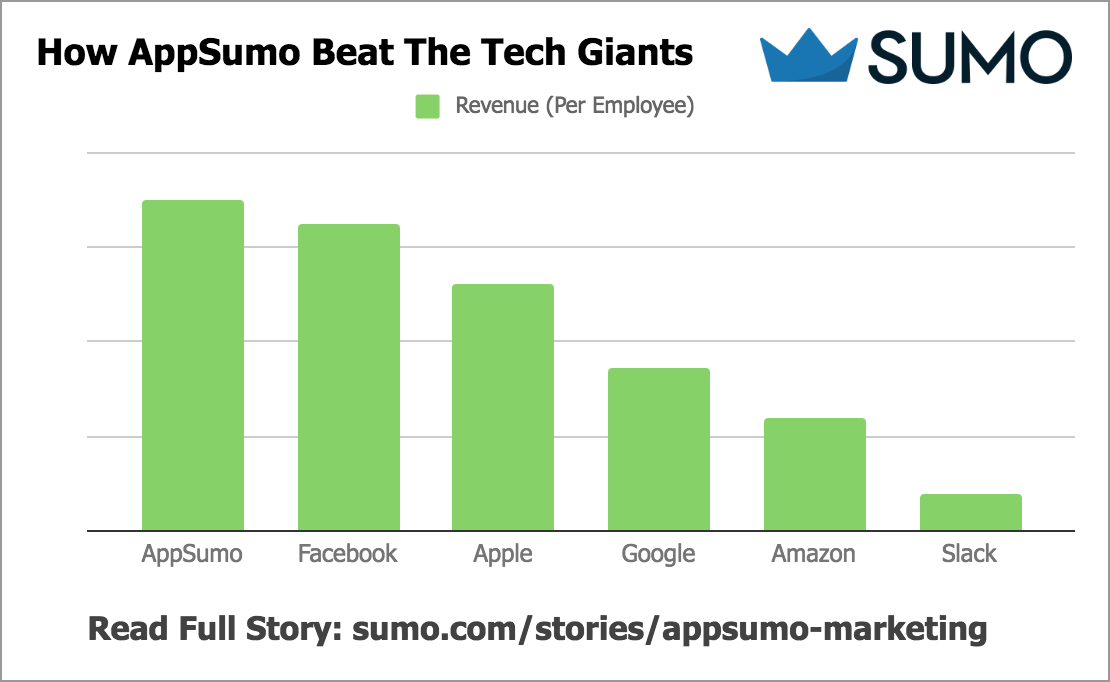
I studied the tech giants’ 2017 10-K Annual Reports and compared their data to AppSumo. Amazon with their $136 billion in revenue and 230,000 employees has over 5,000 times more revenue than AppSumo, but let me ask you this question…
Would you rather run:
- A big, Nasdaq-listed company with thousands of employees OR
- A small, multimillion dollar business with 10 people you know by name, go surfing with in Hawaii, and get together with to chow down on tacos every week?
If your answer is 1, then read this article I wrote on how Amazon generates $136 billion in revenue.
If your answer is 2, then keep reading (you’re in for a treat).
AppSumo is the go-to ecommerce website for entrepreneurs to get lifetime deals on their favorite software. The AppSumo business model and marketing are so successful that a small nine-person team led by CEO Ayman Al-Abdullah (ex-Microsoft) took AppSumo from making millions per year to millions per month in the last two years with no outside funding.
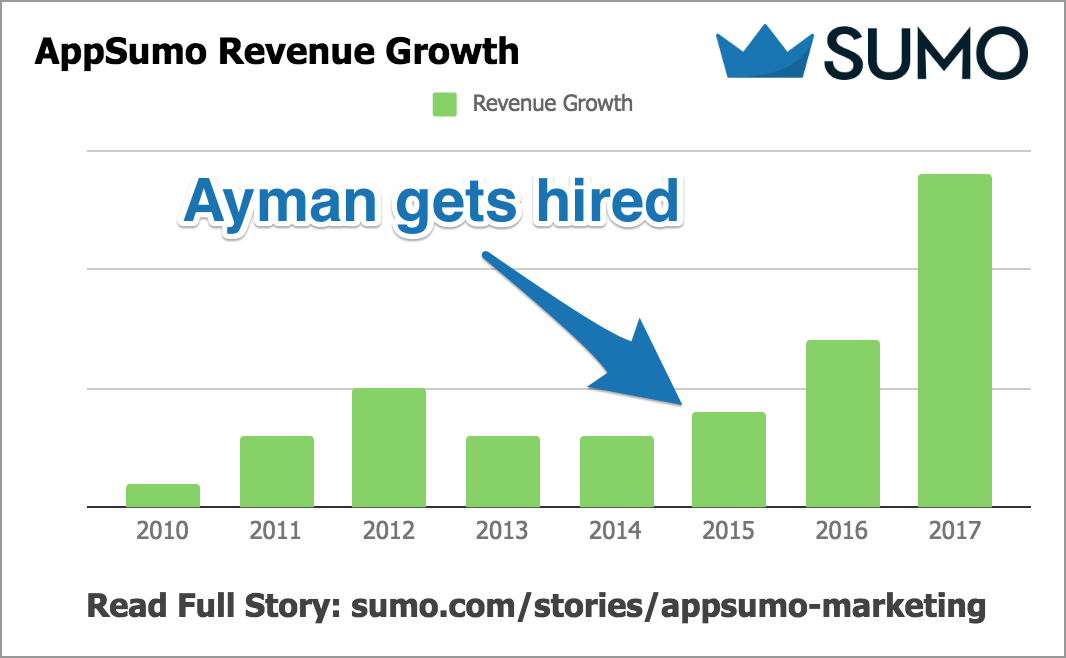
As you read this, be aware that what AppSumo did is insane, but they DON’T keep all the revenue for themselves. In fact, they've paid out over $13.9 million to their partners whose products they help promote to millions of entrepreneurs.

And they spend A LOT on expenses that come with helping startups reach millions of eyeballs:
- Affiliates (who promote AppSumo products to their audience).
- Paid Advertising (to help startups reach audiences they could never reach by themselves with their small marketing budgets).
- Employees (a small elite group dedicated to promoting the startups AppSumo partner with).
At its core, AppSumo was built to help promote cool products. Sit up straight, lean a little closer, and put your reading glasses on as I show you the key marketing tactics AppSumo use to promote the world’s coolest products.
Note: Nothing in this case study is based on conjecture or theory. I traveled to Austin, slept in the AppSumo office, ate their tacos, and extracted every last business, life, and marketing nugget out of the world-class team behind AppSumo’s success. They gave me the inside scoop on exactly what they do and how they do it.
Get Access To AppSumo’s Full Playbook (PDF Version)
Table of Contents
%(tableofcontents)
[Tip #1] The Kopywriting Formula Of A $250,000 Ecommerce Sales Page
There’s one reason why AppSumo has some of the most die-hard fans (affectionately known as Sumolings) compared to all other companies on the internet. It’s the same reason they can convert email leads into over $250,000 in sales when they send one email.
The reason: kopywriting.
AppSumo has developed a unique brand voice. It is a personal voice… a good friend of yours from college who can explain things simply and you enjoy interacting with them. Some key characteristics that make AppSumo’s copy so compelling include:
- They don’t make you feel stupid
- They joke around
- They can make the boring seem exciting
- Not too cheesy or meme overload
- Not too wordy or corporate
- Show real results
- No over-promising
- No clickbaity
- No used car salesman
- If it’s a serious topic, they’re more direct
Here’s an example of a very well copywritten headline that matches AppSumo’s brand voice and audience (if you don’t understand the DJ Snake and Lil Jon song reference, you likely aren’t AppSumo’s ideal customer anyway):
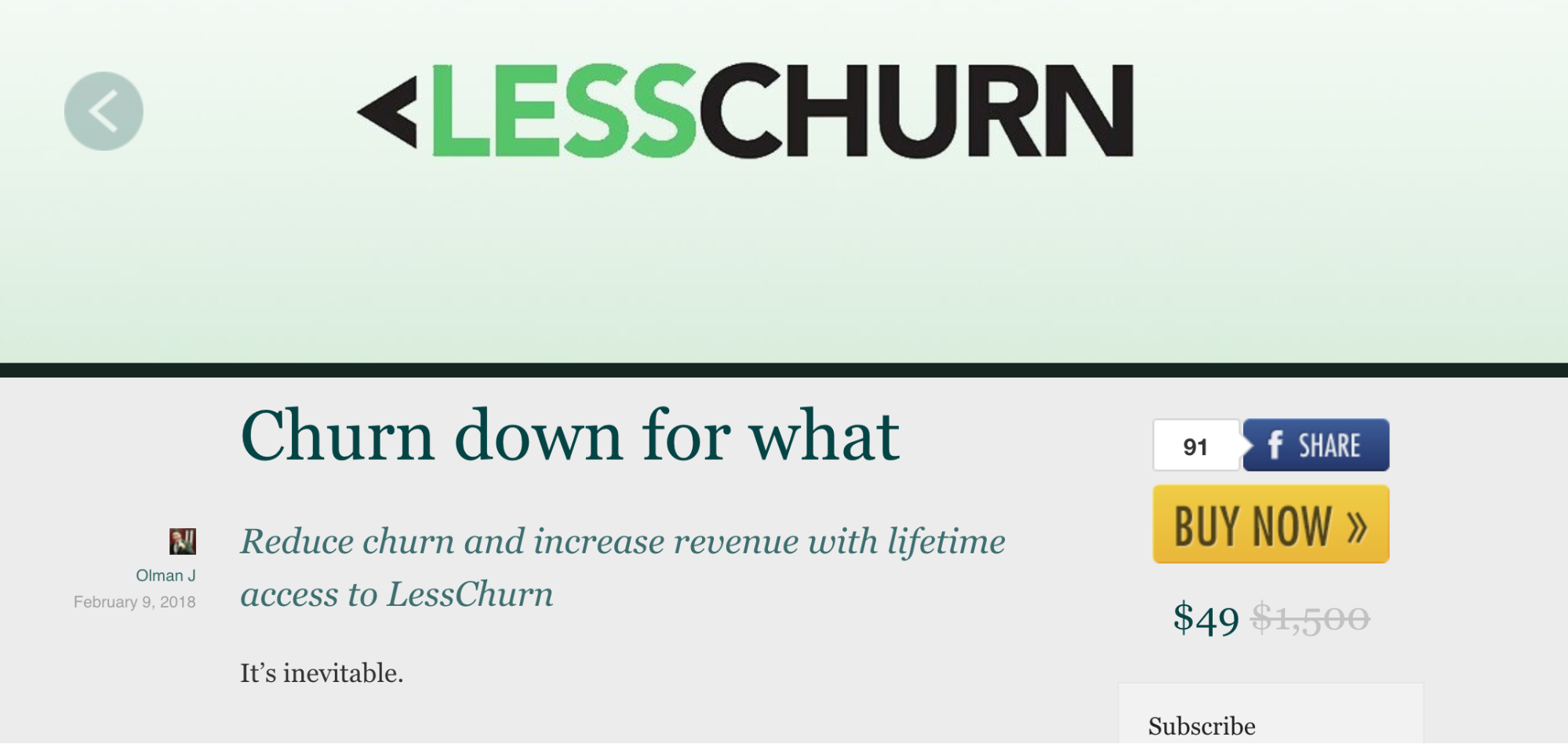
AppSumo is like the golden retrievers of the marketing world; reliable, friendly, personable and a little silly, but wise, loyal and humble at the same time.
The guy who started it all: Neville “The Brown Santa Claus” Medhora
To see how Neville “launched” AppSumo’s brand voice to the world, watch as Noah and Neville deconstruct the exact email that AppSumo sent to land their first (almost $10,000) deal:
Since the Kernest font deal, AppSumo has gone on to do deals with over $250,000 in revenue using short 500-word sales pages. To show you exactly how they do it, I’ve broken down AppSumo’s CloudApp deal page section-by-section.
1. Headline (short and intriguing, usually mentioning the benefit)
2. Subheadline (a bit more detail about the benefit)
3. Problem (common problem people have when not using the product)
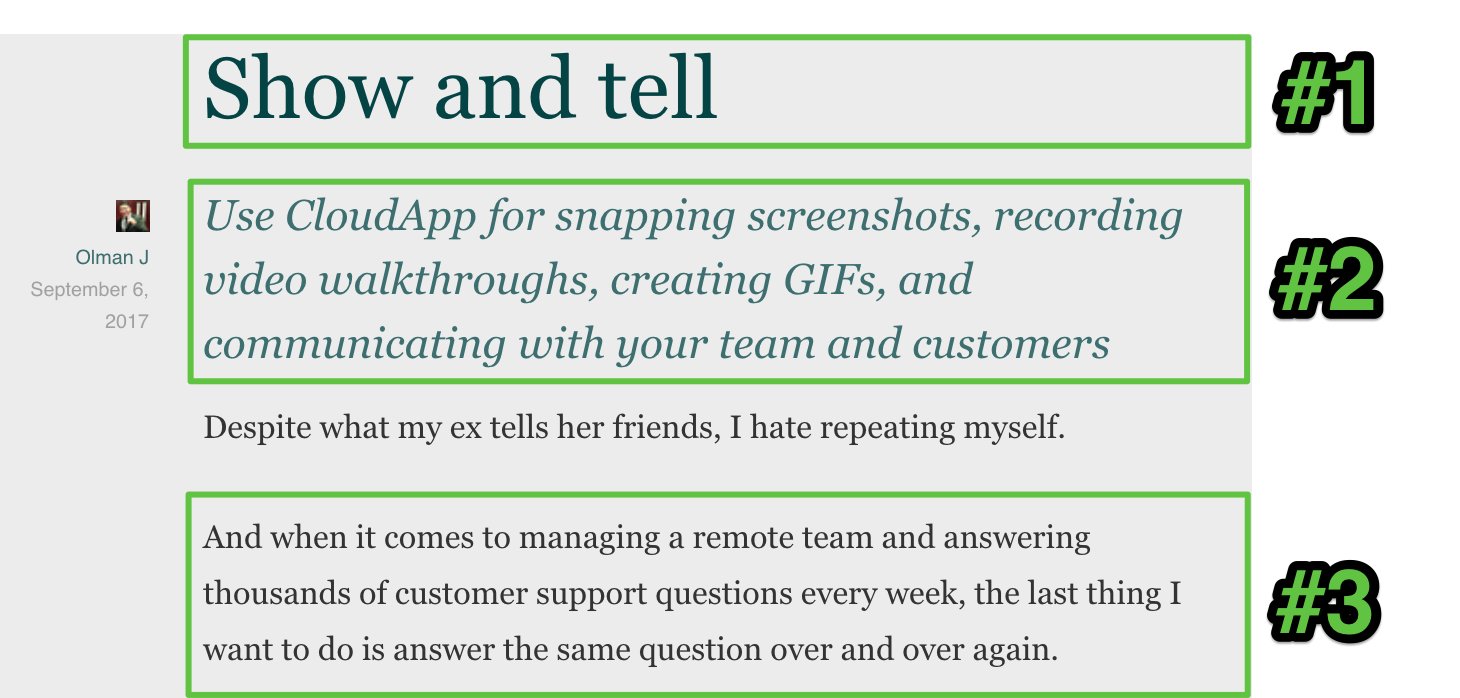
4. Video (add it in if you have one to increase credibility)
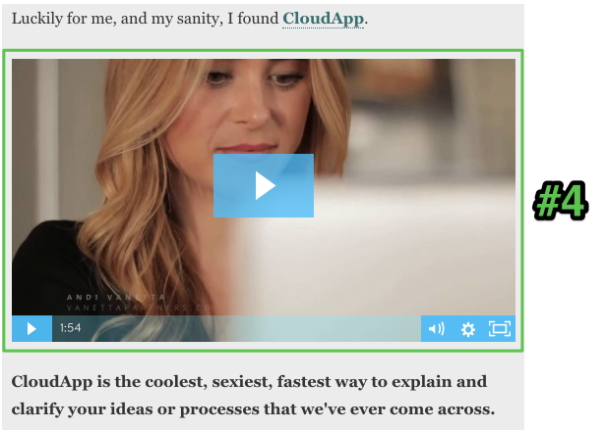
5. Pictures (demonstration of how to use the product)
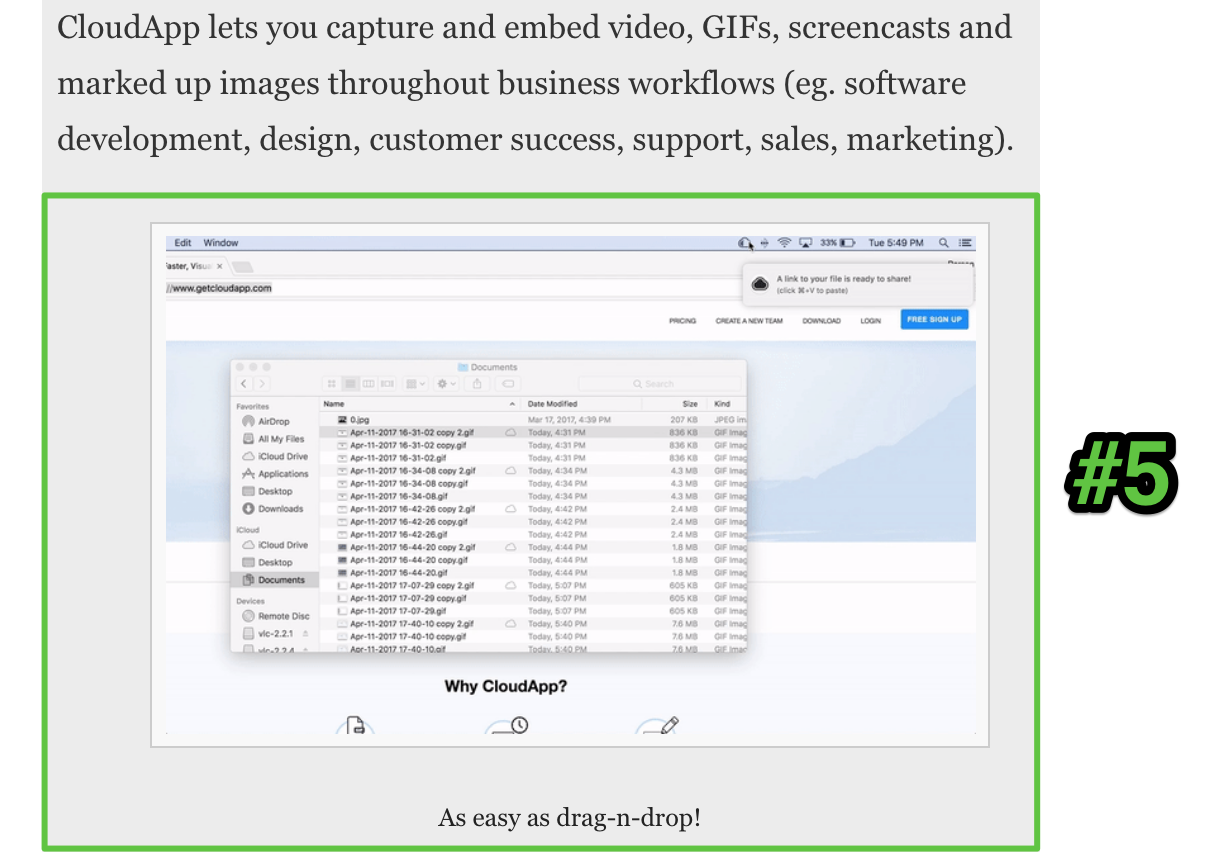
6. Internal validation (mention how you are using it, or showcase how another popular brand uses it)
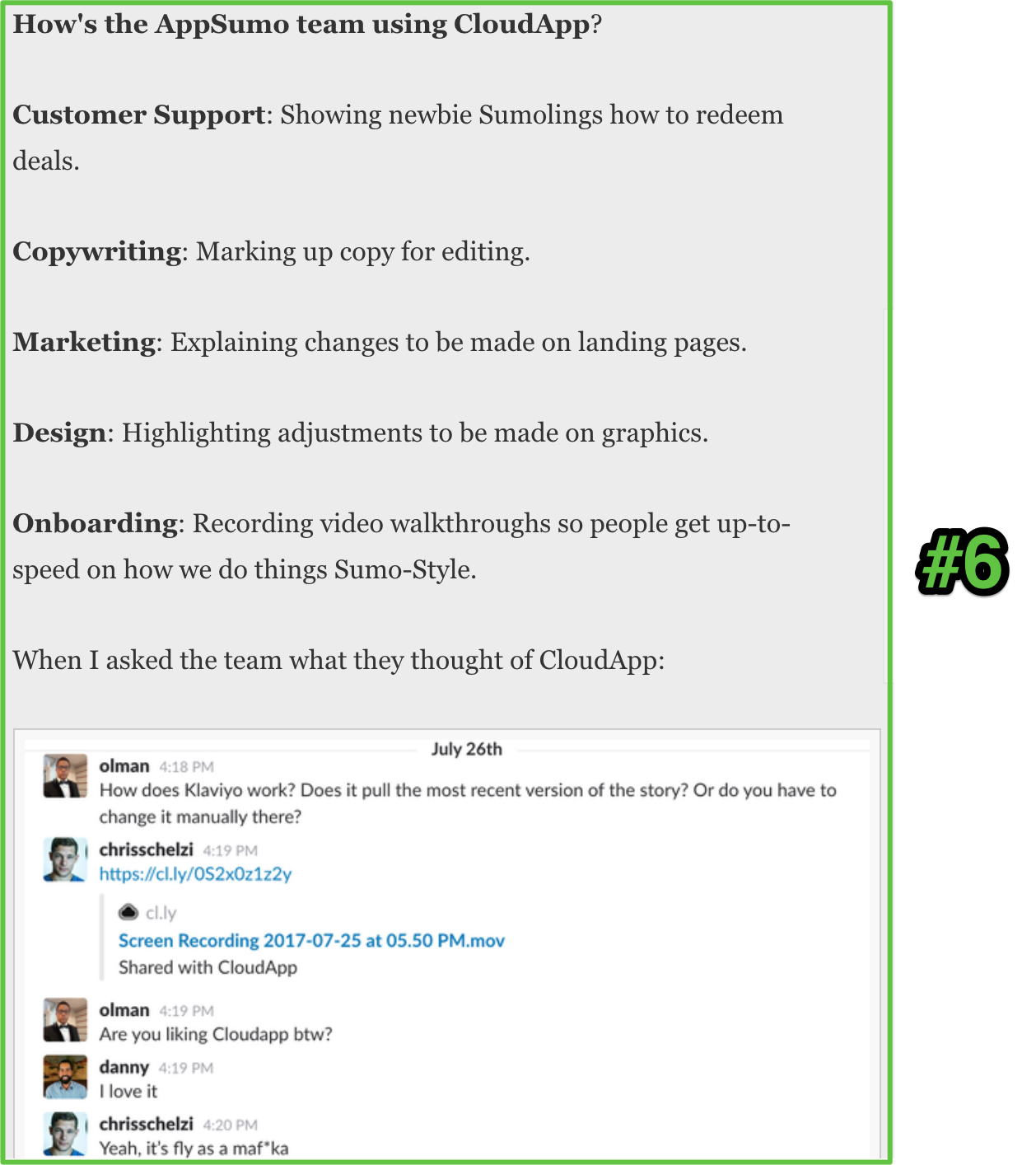
7. Examples (of how you can use the product)

8. Original price (show it and validate it by mentioning how you or someone else pay that price)
9. AppSumo price (show it and tell people they can get lifetime access with a link to buy it now)
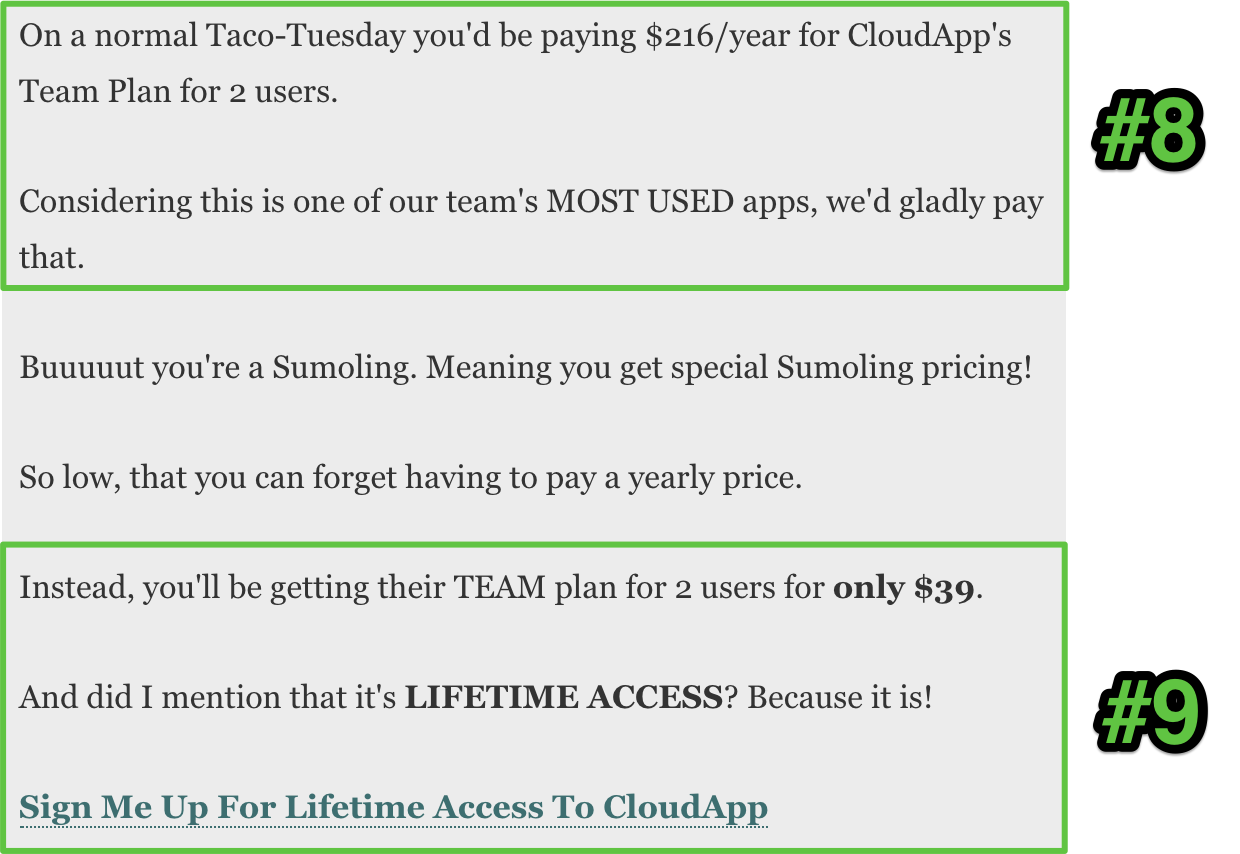
10. Testimonial (show a real testimonial from someone who’s already bought the product with 5 tacos from when you beta-tested the deal)

11. Objections (go through common objections and debunk them)
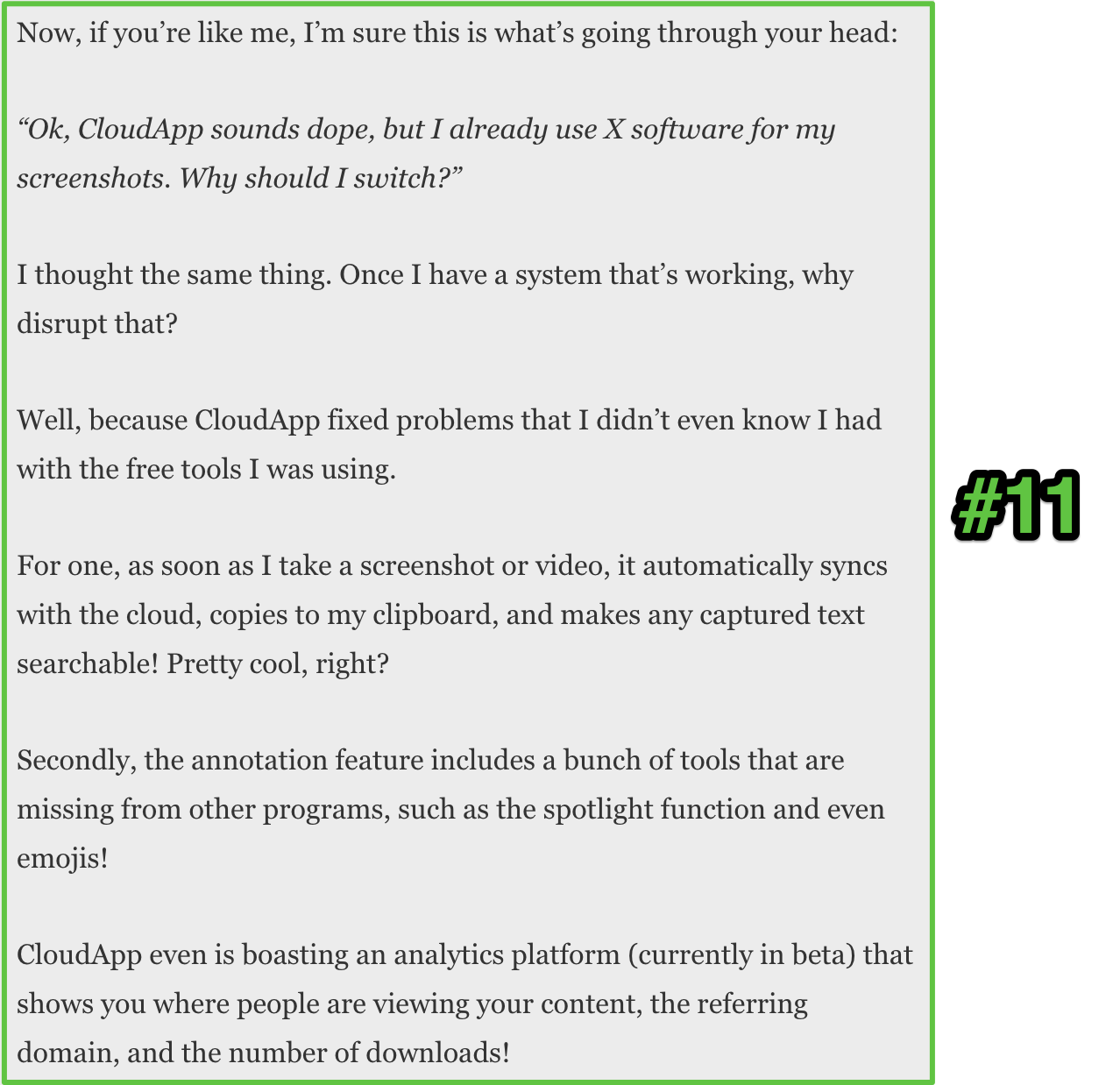
12. Benefits (all the cool things you are about to get)

13. Offer (final call to action to buy the product)
14. Scarcity (time until deal closes, how many deals are left)
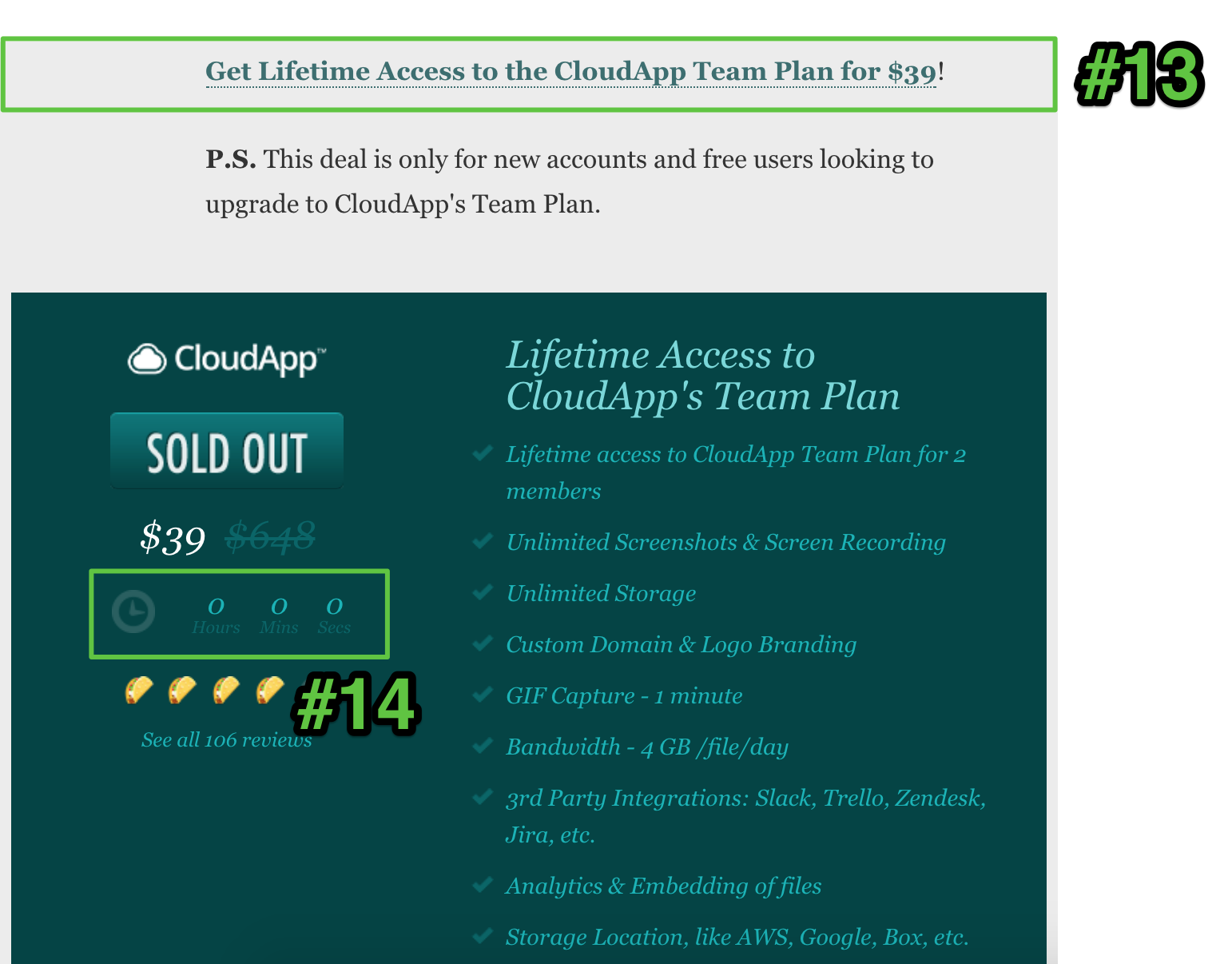
15. Social proof (reviews and questions from qualified traffic you send to deal page automatically sorted by most upvotes to kill spammers)

Golden Nugget: Don’t write your sales page in Google Docs, Word, or your email editor. Write it inside Facebook messenger. It will help you write like you’re writing to a friend (then copy it across to your website).
You don’t need a long sales page to sell a lot of product, but it’s critical that you have every element I covered above if you want your sales page to convert people.
The takeaway: Use the AIDA formula to write short 500-word emails and sales pages that capture attention and inspire action. Tony Robbins uses the AIDA formula to generate leads on his home page with his AIDA lead generation quiz. AppSumo uses it to sell millions of dollars worth of products via email, with this 15-part AIDA sales page framework:
Attention:
1) Headline (short, intriguing, usually mentioning the benefit)
2) Subheadline (a bit more detail about the benefit)
3) Problem (common problem people have when not using the product)
Interest:
4) Video (add it in if you have one to increase credibility)
5) Pictures (use case of how to use the product)
6) Internal validation (mention how you are using it, or if you’re not using it then showcase how another popular brand uses it)
7) Examples (of how to use the product)
Desire:
8) Original price (show it and validate it)
9) Your price (show it and tell people they can get lifetime access with a link to buy it now)
10) Testimonial (show a real testimonial from someone who’s already bought the product)
11) Objections (go through common objections and debunk them)
12) Benefits (all the cool things you are about to get)
Action:
13) Offer (final call to action to buy the product)
14) Scarcity (time until deal closes, how many deals are left)
15) Social proof (reviews and questions automatically sorted by most upvotes to kill spammers)
[Tip #2] 10x Your Email List With Quarterly Giveaways (Hint: Viral Coefficient k>1)
Every quarter AppSumo tries to do one giveaway. The first giveaway they did in October 2012, a giveaway for 10 Dropbox lifetime licenses, helped the company grow their email list by 200,000 people.
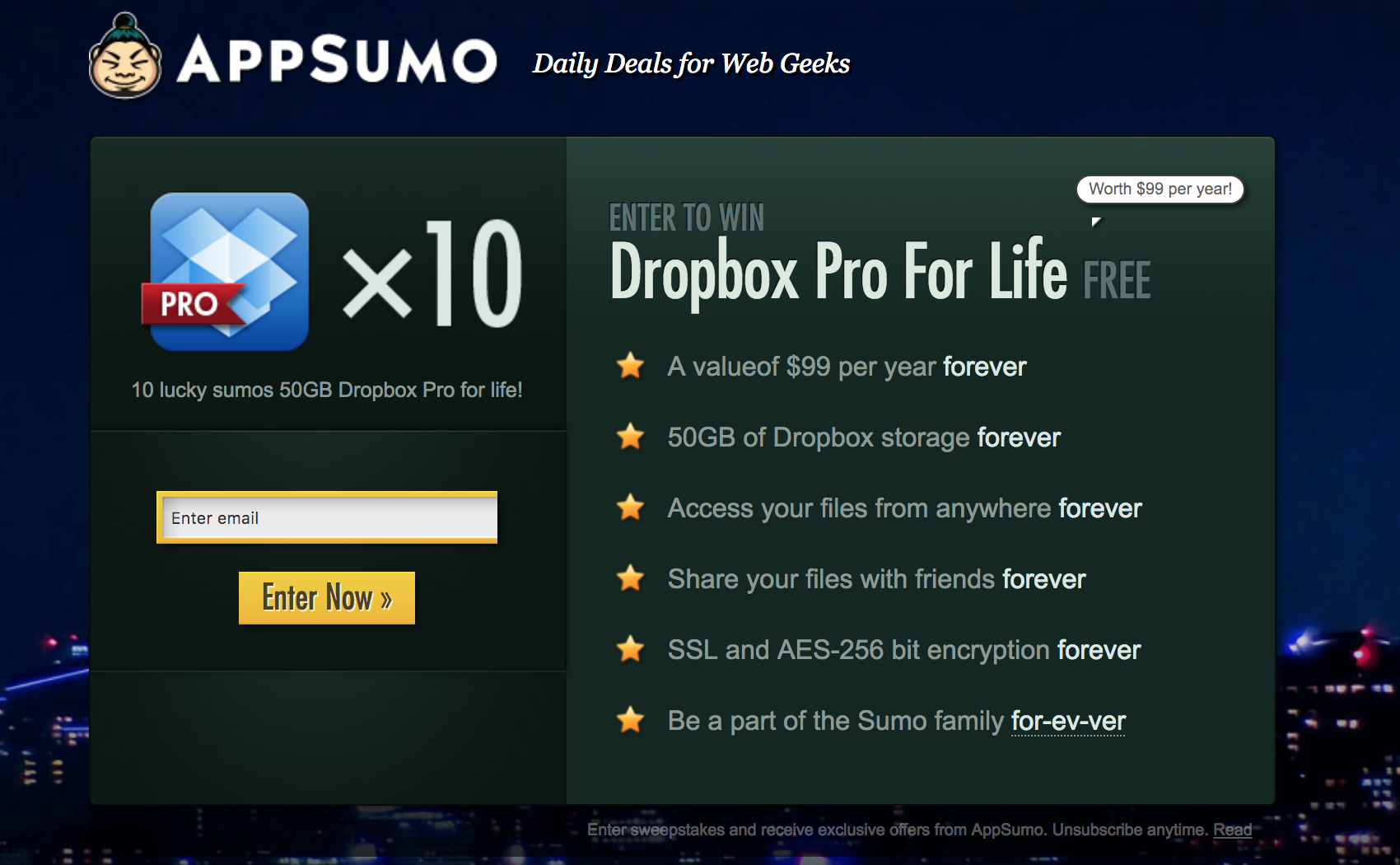
Noah Kagan was drinking on a Friday night when he got inspired by a giveaway he saw on a women's deal site called Bloomspot. He was going to do the giveaway “ghetto” (without coding anything), but Chad Boyda (now CEO at Sumo.com) coded it up so people could get extra entries for referring friends.
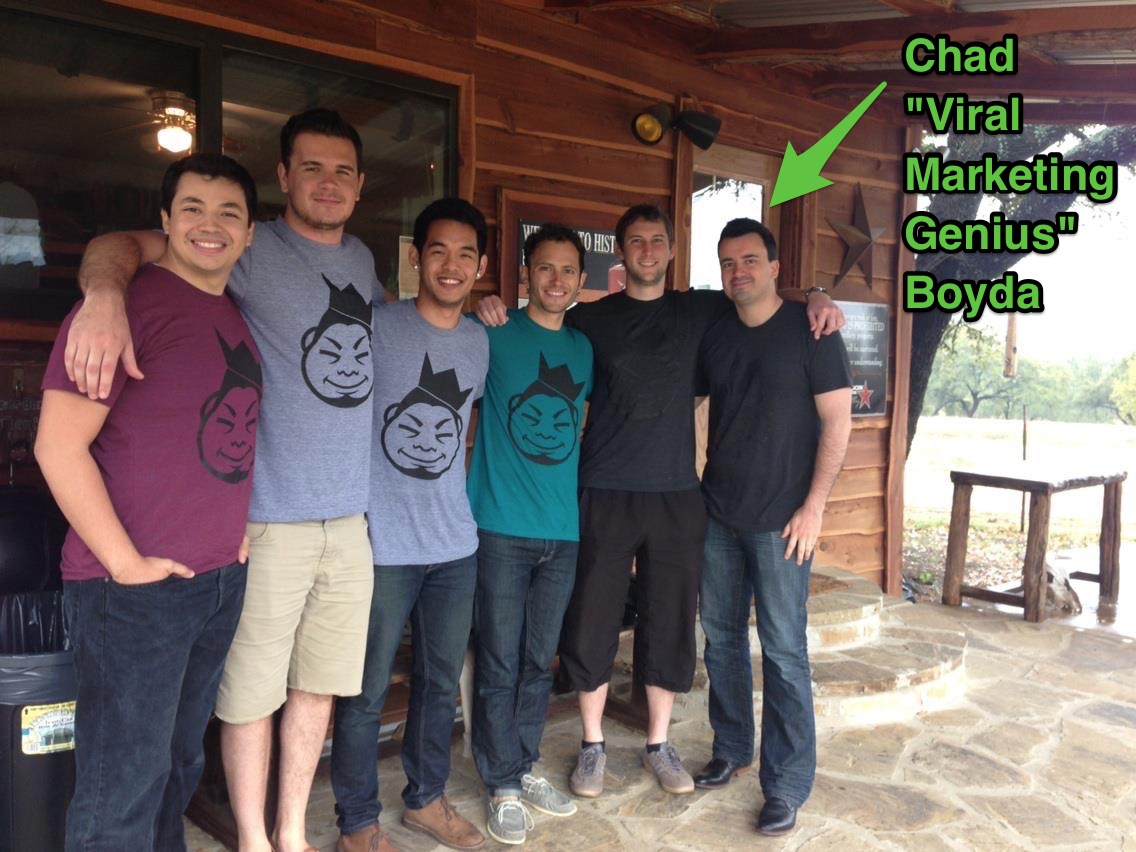
They launched it the next Wednesday (five days after having the idea). After one week the giveaway generated over 200,000 email signups.
Regularly, it cost AppSumo around $5 to get an email subscriber through online ads like Facebook back in 2012.
The giveaway cost them $60,000.
$1,200 a year (cost of Dropbox for a year for 10 people) multiplied by people living 60 years = $60,000
Instead of paying $5 per email subscriber, AppSumo got 200,000 email subscribers for only $0.30 each with this giveaway.
To get Sumo-sized results (like Chad and Noah did with the Dropbox giveaway) you need to try new channels and new marketing techniques before others do. A giveaway with insane results like this is not common, however. There were a few key factors Noah told me that made this so successful:
- It was viral with KingSumo (Chad coded the early version of KingSumo for AppSumo to use internally and it went viral because of the referral entry feature)
- It was early in the life cycle of Facebook and Twitter so social media spread faster and wasn’t as crowded with other posts from your friend’s taco-eating competition
- The early adopters of the social media platforms were AppSumo’s target market
- Noah was willing to experiment quickly with using giveaways as a new marketing tactic, and not many other people were using them yet (it only took Noah and Chad five days from idea to execution)
More recently, Chris Schelzi (AppSumo’s Head of Marketing) ran a giveaway for a growth hacker bundle with five winners that generated 30,822 entries.
These weren’t just people on AppSumo’s 1,700,000+ email list either. 18,564 of these were new entries—people not already on their email list.
Chris tracked this cohort, and many of AppSumo’s best customers came through this giveaway. He measured “best” by looking at the lifetime value of customers who came through the giveaway versus AppSumo’s average customer lifetime value (CLTV). In 2016 AppSumo’s average CLTV was $163.96; in 2017 Chris helped increase that average by 55.53% to $255.
To get a high CLTV with the giveaway, Chris got a bunch of partners who have a similar audience to AppSumo to DONATE their tools, so AppSumo had to pay very little to get in front of a targeted audience, but was able to give away prizes with a total value of $28,260.
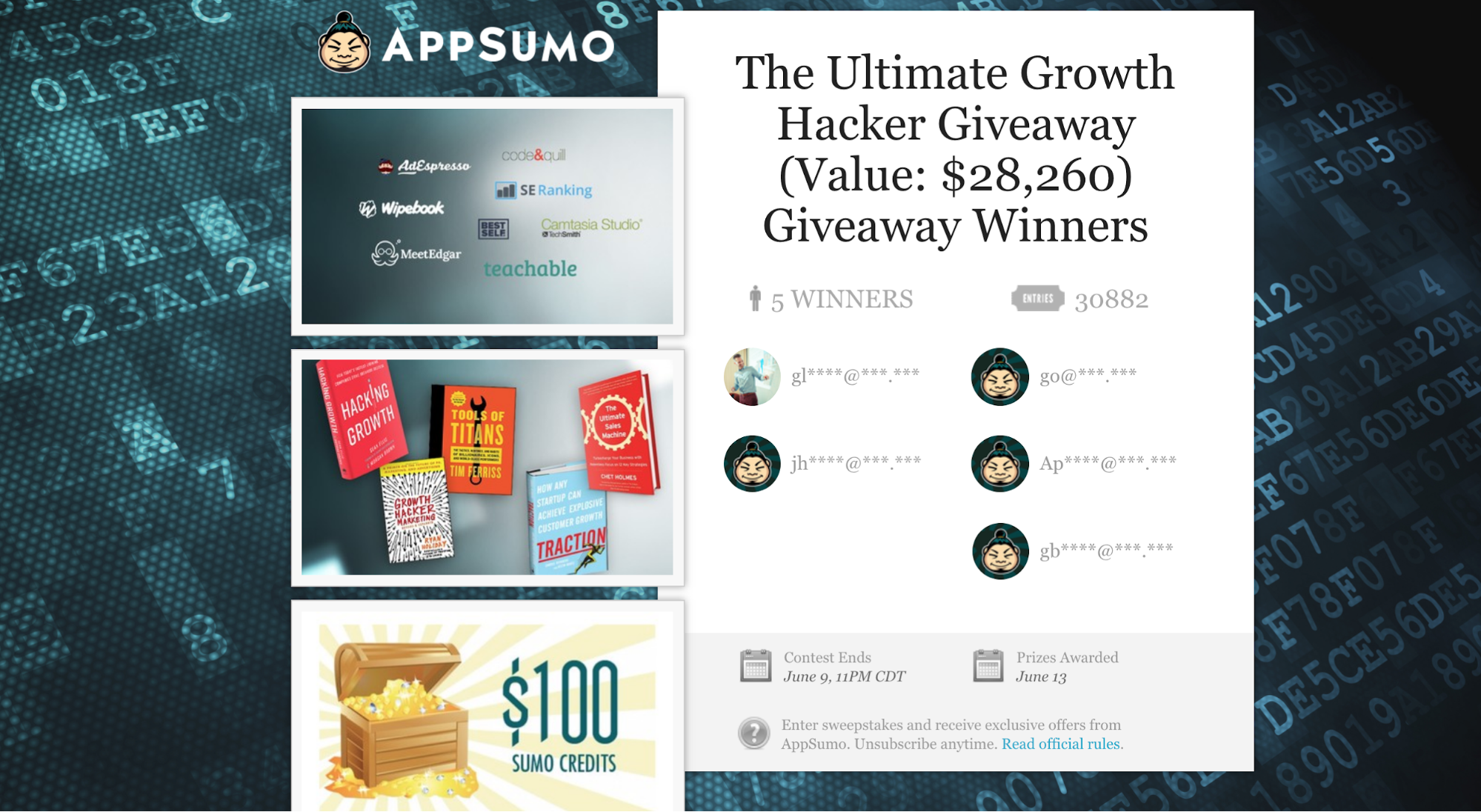
Golden Nugget: To reach a new audience, Chris bought five books from five different authors, and got eight software and two eCommerce companies to donate products. This gave AppSumo 13 potential opportunities to cross-promote with their partners' audiences.
Here is the seven-step process Chris uses to get partners to donate products and share AppSumo’s giveaway, and how you can use it for your business:
1. Create a list of all the companies you want to partner with for your giveaway
2. Find the CEO and CMO of that company
3. Email the CEO and copy the CMO on the email. Why both? Because chances are it’ll work one of three ways:
1) The CEO will like the idea and then pass it along to the CMO to execute (accountability)
2) The CMO will think it’s a great marketing idea that’ll make them look good and then will pitch the idea to the CEO and convince them for you
3) Each could think the other will answer (so make sure to send the email to the CEO and copy the CMO, not the other way around)
4. Highlight the major benefit your partner will get by participating when you pitch the giveaway (Chris highlighted the huge exposure partners would get to be in front of the 700k+ email subscribers AppSumo would email). Then make a small ask to get your first little “yes.” Here is the first pitch email Chris sent:
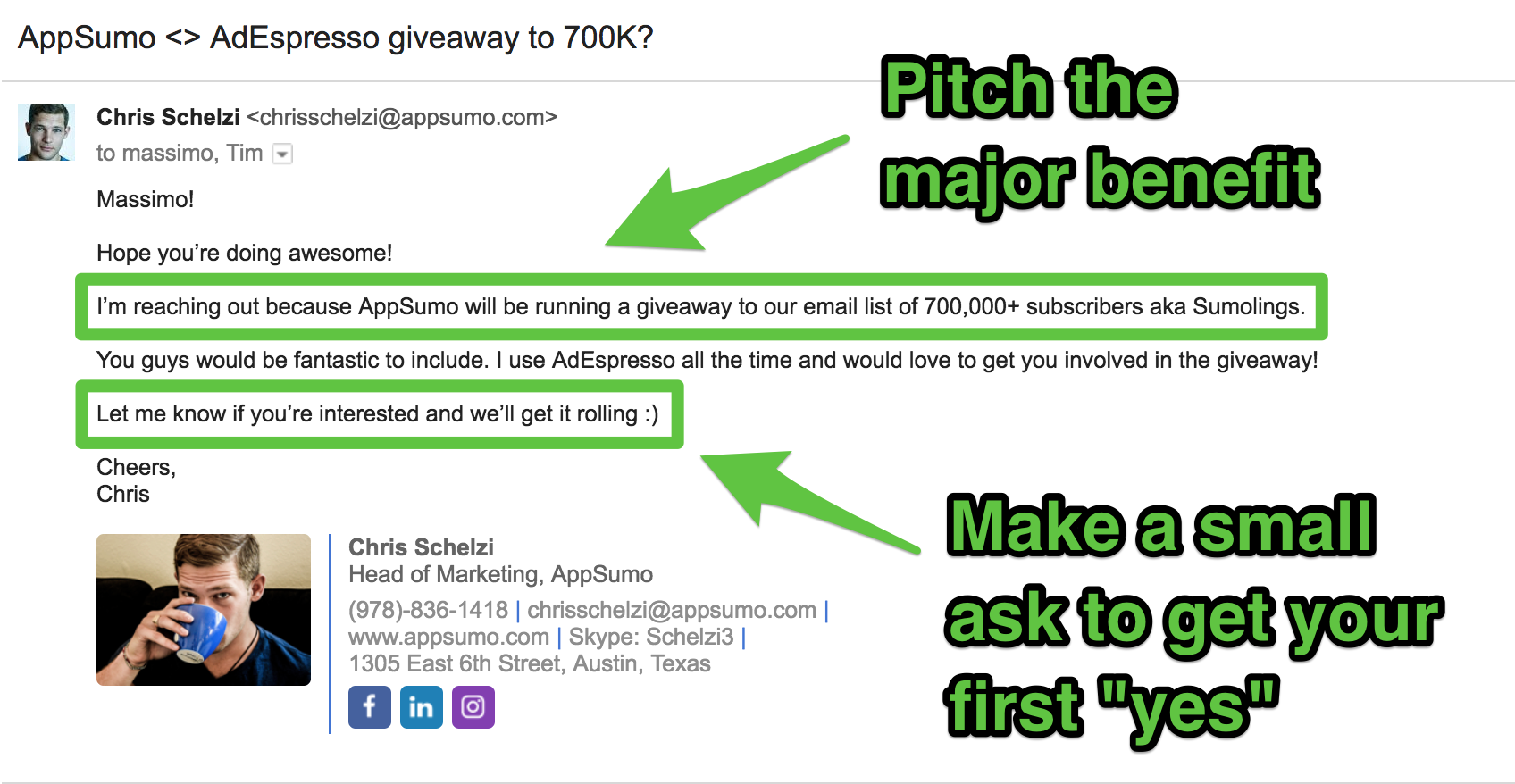
5. Once they agree to be a part of the giveaway, add in social proof, why it will work for them, the halo effect of other companies doing it, and say “OK, I’ll need 10 free licenses” or whatever. If you ask for a bunch of free things in the first pitch email, it’s much more likely to get shut down. Here is the second email Chris sent, where he outlines how the giveaway is going to work and adds more value to the partner (see P.S. in email):
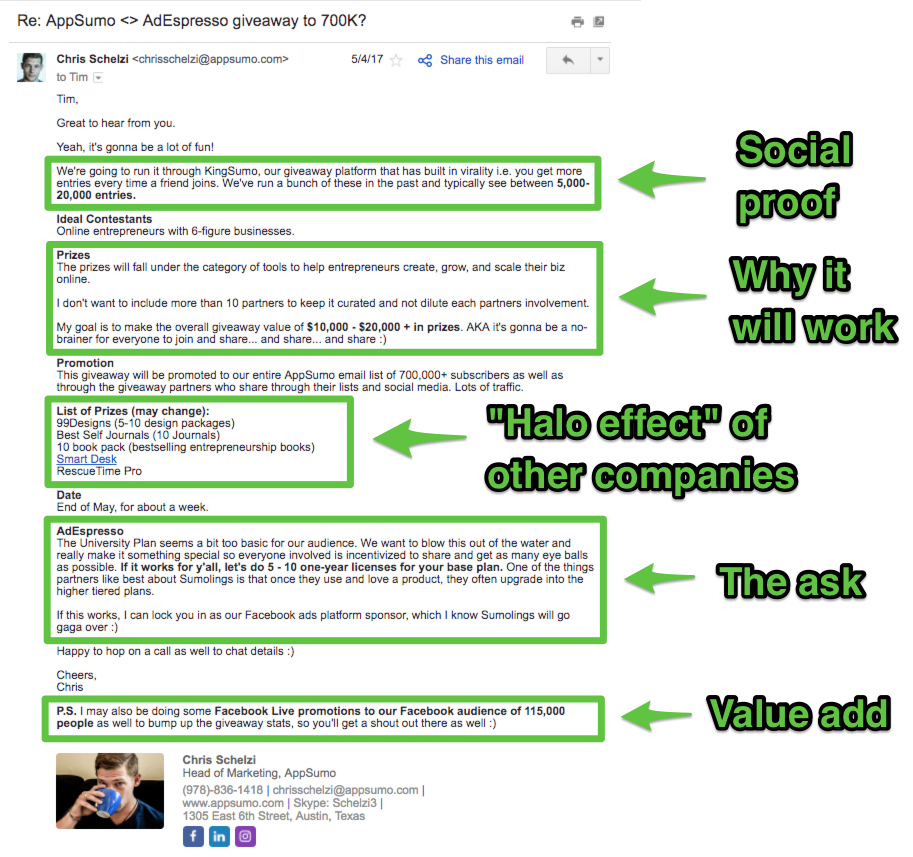
6. Collect all the prize codes and freebies ahead of time. For physical products (notebooks, etc.) it’s better to have the partner mail them directly to the winner. Much easier for your logistics.
7. When the giveaway goes live, email all the giveaway partners with a media kit (see below) and ask them to promote the giveaway to their audience. This makes it as easy for them as possible to help share your message. Here is the email Chris sent:
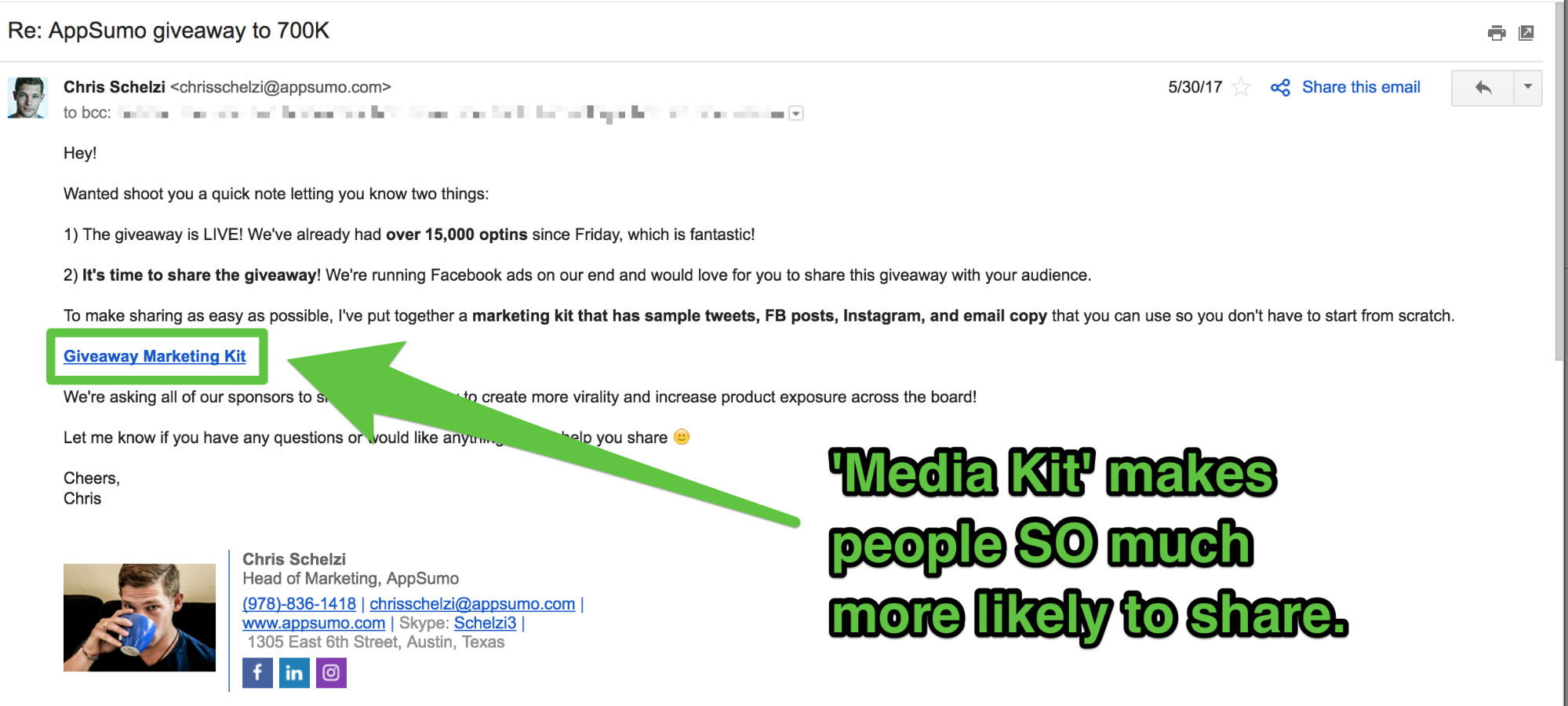
Golden Nugget: Add a tracking link to your Media Kit so you can track how many people click it, to get an idea how effective it is.
The media kit Chris put together gave people tweets, Facebook posts, email copy, graphics and assets, links, etc. Chris used this before when promoting a crowdfunding campaign in the past (at a different company) and it led to nearly $50,000 in direct revenue from the promotion partners.
Get Access To The Giveaway Marketing Kit Chris Uses
After the giveaway ends, Chris sends a thank you email to all partners. He does not share the collected email addresses with partners; their benefit is getting exposure to millions of people through all of AppSumo’s promotion of the giveaway.
Use this three-step process from AppSumo to promote your quarterly giveaways and get thousands of email signups:
Step 1: Buy a KingSumo license.
This is the software tool AppSumo uses to run all their giveaways. In the video, you can see the 34 giveaways AppSumo has run since 2011 and how Noah built KingSumo into a $1 million business.
There are a lot of reasons why KingSumo is the best tool to use, but the main one is that true virality is engineered into the tool.
To make a giveaway go viral, you need to get a viral coefficient >1. That means turning every one giveaway entry into at least 1.1 entries (i.e., for every 10 people that sign up, there’s an 11th that signs up). The higher your viral coefficient is, the better your giveaway will perform.
The best way to increase your viral coefficient is for people to “share” your giveaway page (not like, follow, comment, etc.). KingSumo has designed their software so that once someone enters your giveaway, the first four actions they are incentivized to take is sharing your giveaway across the four biggest social media platforms (Facebook, Twitter, LinkedIn, and Pinterest).
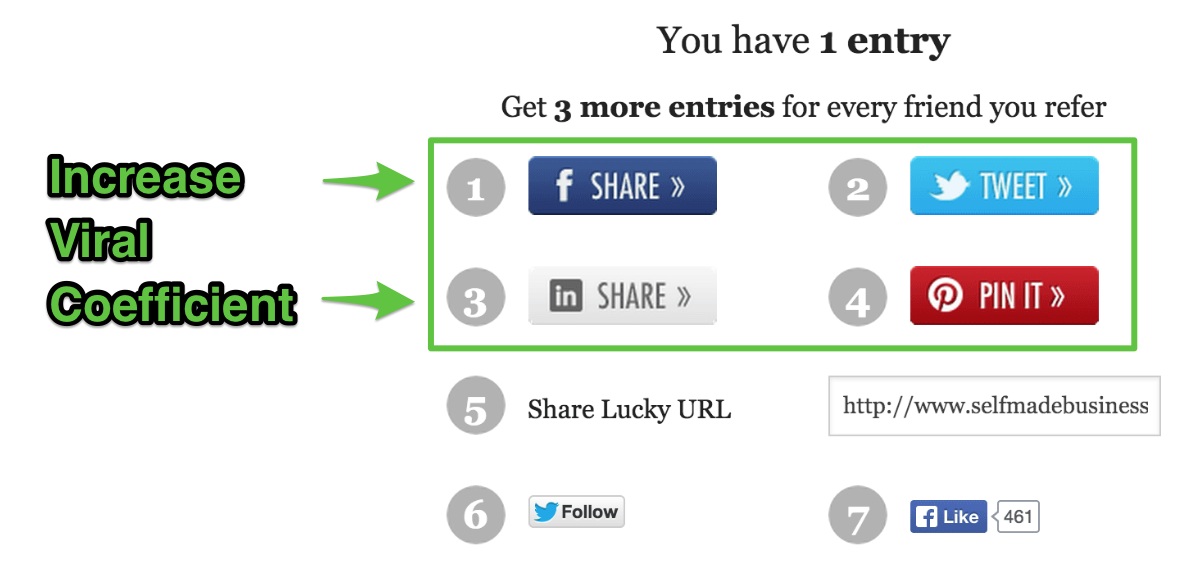
When someone clicks one of the sharing buttons, your post copy and image is automatically inserted and optimized to make it one-click easy for entrants to share your giveaway and get more entries.
Step 2: Pick a great prize with WOW factor.
The key to a successful giveaway is picking a prize that:
- Your target customer wants
- Will inspire action (aka has WOW factor)
If you don’t follow number one, you’ll get email signups that aren't directly related to your product and won’t buy later (hint: don’t give away an iPad or iPhone).
You also want to make sure your prize has WOW factor. In other words, when your target audience hears the headline of your giveaway, it makes them want to drop everything and enter your giveaway.
Here are three “WOW factor” examples to get your creative juices flowing:
- Business: Window installation company
- Business: Luxury car sales company
- Business: Cryptocurrency trading company
Prize: Voice-controlled shutters for your entire house
Prize: Lease on a Mercedes for one year
Prize: Trezor wallet with $1,000 bitcoin
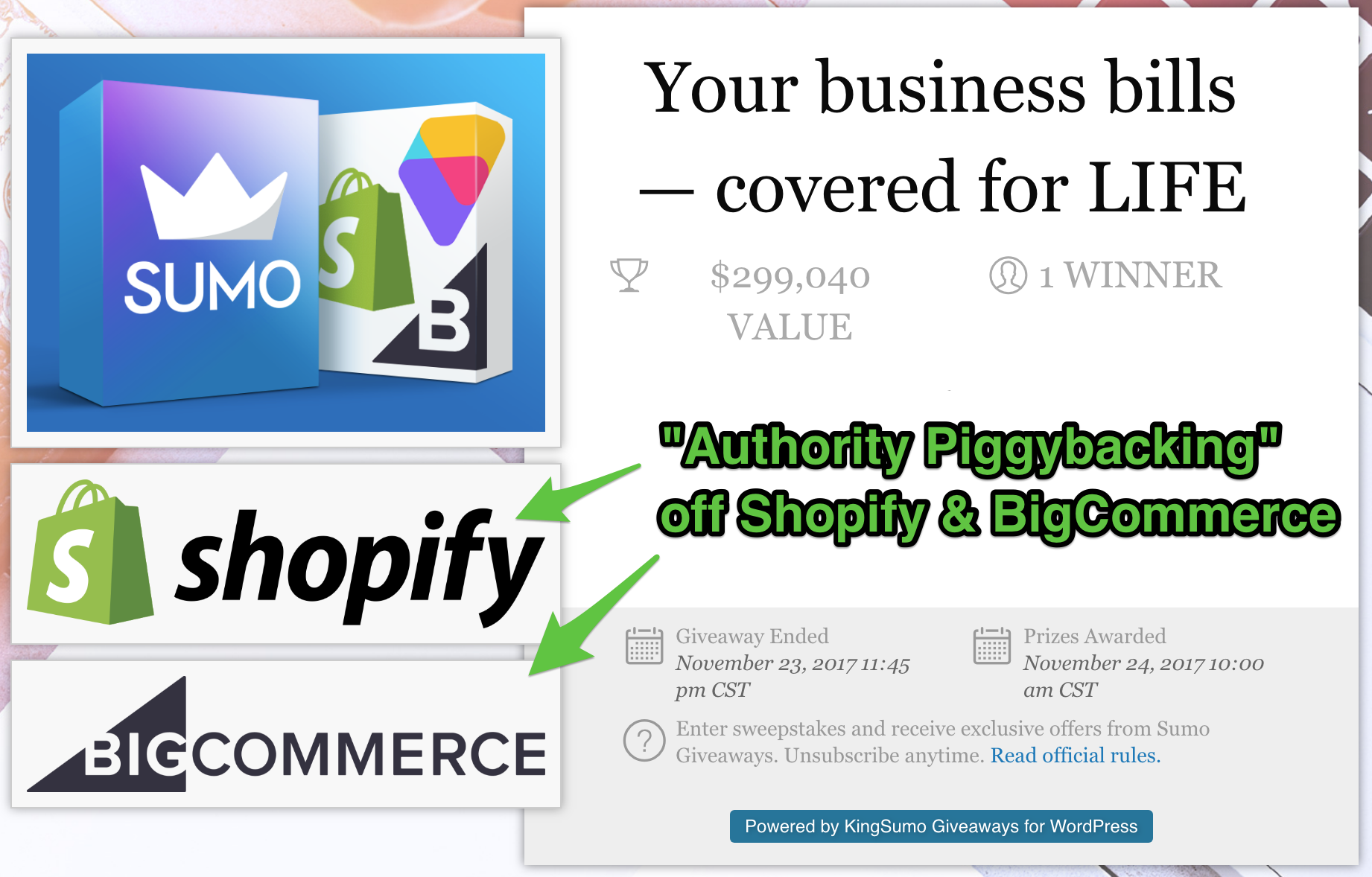
Golden Nugget: Use “Authority Piggybacking” by picking a prize owned by a company that will help you promote your giveaway (like Chris did above with The Ultimate Growth Hacker Giveaway). This can help you piggyback off the audience of the prize owner and be laser-targeted with your promotion.
Step 3: Promote your giveaway.
If you’ve followed Step 1 and Step 2, then you don’t need to do a lot to promote your giveaway in Step 3. You just need to give your giveaway the initial push to get it in front of your target audience.
Here is a simple promotion checklist you can follow:
1. Send to your email list/push notification list/Facebook messenger list (send two emails: giveaway launch email and last-chance email). The email goes to AppSumo’s full email list, and there is no segmentation done because people have the opportunity to earn more entries by sharing the KingSumo giveaway before it ends. Here is the giveaway launch email AppSumo sent:

2. Post on your social media accounts (Chris and Olman did a Facebook Live stream five hours before the giveaway ended for AppSumo)
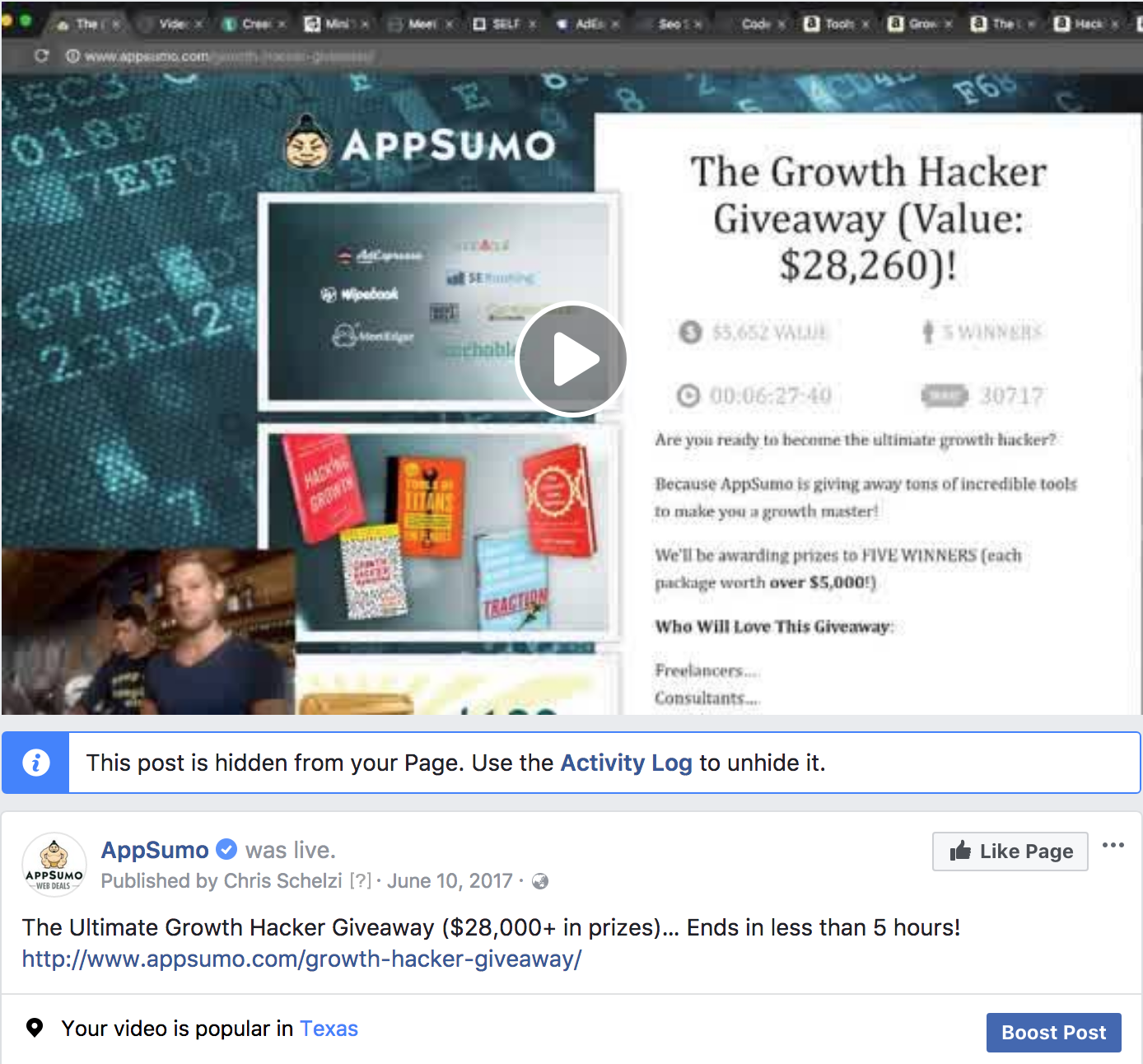
3. Ask your prize partners to email their list and share on their social media. Chris sent this email to partners:
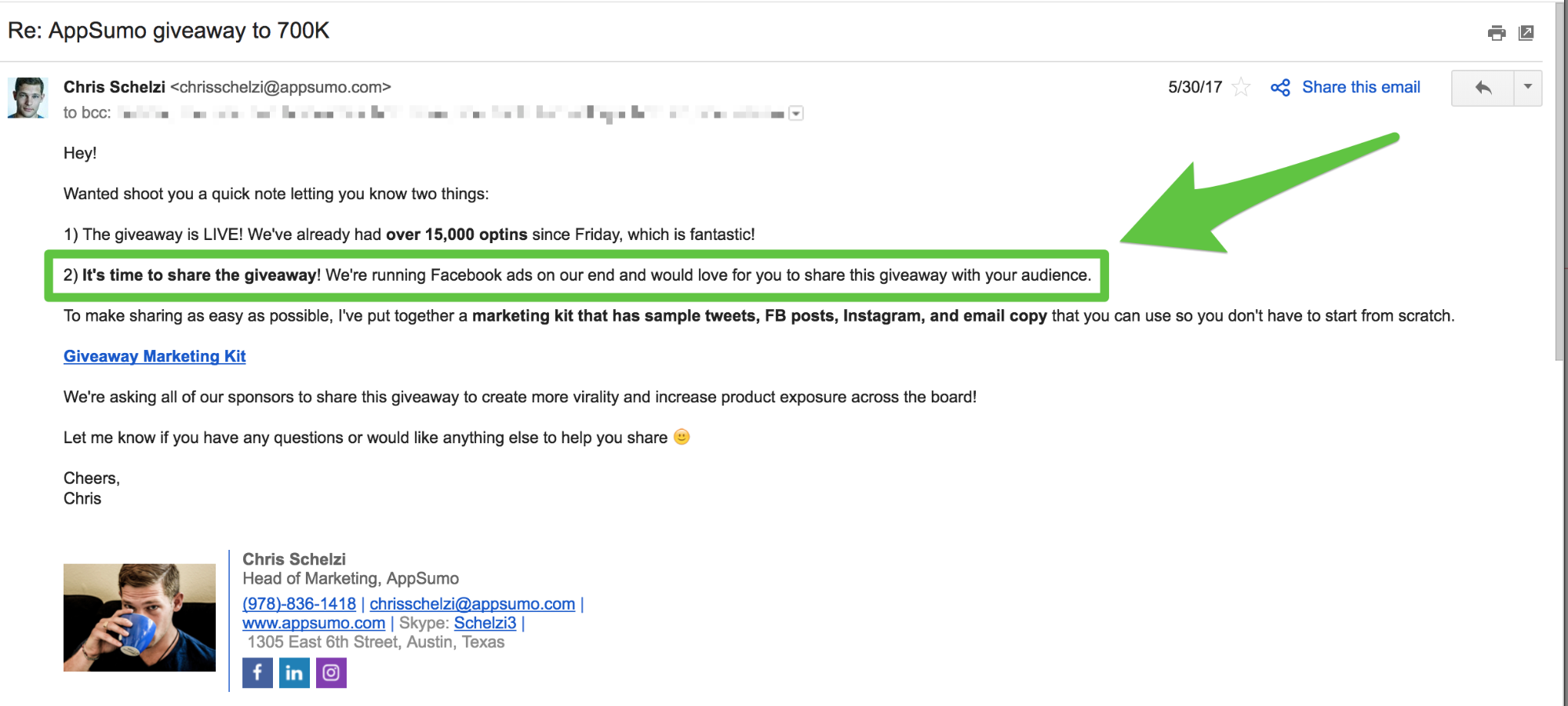
4. Make a list of your friends who have the audience you want to target and ask them to post on their social media
5. Send a small amount of paid traffic to your giveaway page (e.g., if you are giving away Dropbox licenses, advertise to Dropbox fans)
Remember to make it easy for your partners and friends to share by providing done-for-you email swipes and social media assets like Amazon does for their partners when promoting their charity program.
If you are looking for even more promotion ideas, here is a complete list of 134 traffic tactics we’ve put together. However, if you need to over-promote your giveaway, then it probably means your giveaway sucks (i.e., you didn’t follow step 1 and step 2).
The takeaway: Schedule a quarterly giveaway on your marketing calendar to grow your email list. Get KingSumo, pick a great prize relevant to your audience with a unique angle (bonus points if you can use “Authority Piggybacking” like Chris did), and promote your giveaway to get it in front of the people who would crawl over broken glass to get what you’re offering.
[Tip #3] AppSumo’s Top 4 Email List Building Tactics
AppSumo’s whole business model is built around promoting cool products. Their email list is their #1 promotion channel. Most people think popups are annoying, but they aren’t when you time them right. AppSumo has proven that by using popups as their primary email list building tactic.
Here are the top three popups they use (plus a bonus one). Before you copy them, click here to get Sumo (AppSumo uses these behavior-based website popups from Sumo to grow their email list).
AppSumo List Building Popup #1
Popup Type: $100 Freebies Popup
Popup Design: Sumo “Atomic” Template (available inside Sumo)
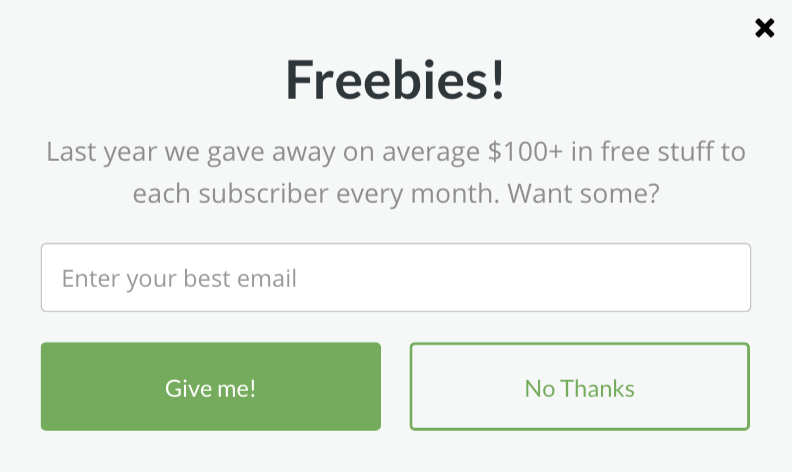
Timing and Display: 15 seconds after being on the website

Result: 78,888 email optins

Why It Works:
- It’s timed to only show after someone has been on the AppSumo website for 15 seconds, so the visitor has had time to browse the latest product/deal before getting asked for an email.
- AppSumo’s audience (early-stage entrepreneurs) is looking for great deals, so the marketing copy matches what they are seeking.
- The value proposition is simple: get $100+ in free stuff every month.
AppSumo List Building Popup #2
Popup Type: New Product Popup (Optimized For Mobile)
Popup Design: Sumo “Focus” Template (available inside Sumo)
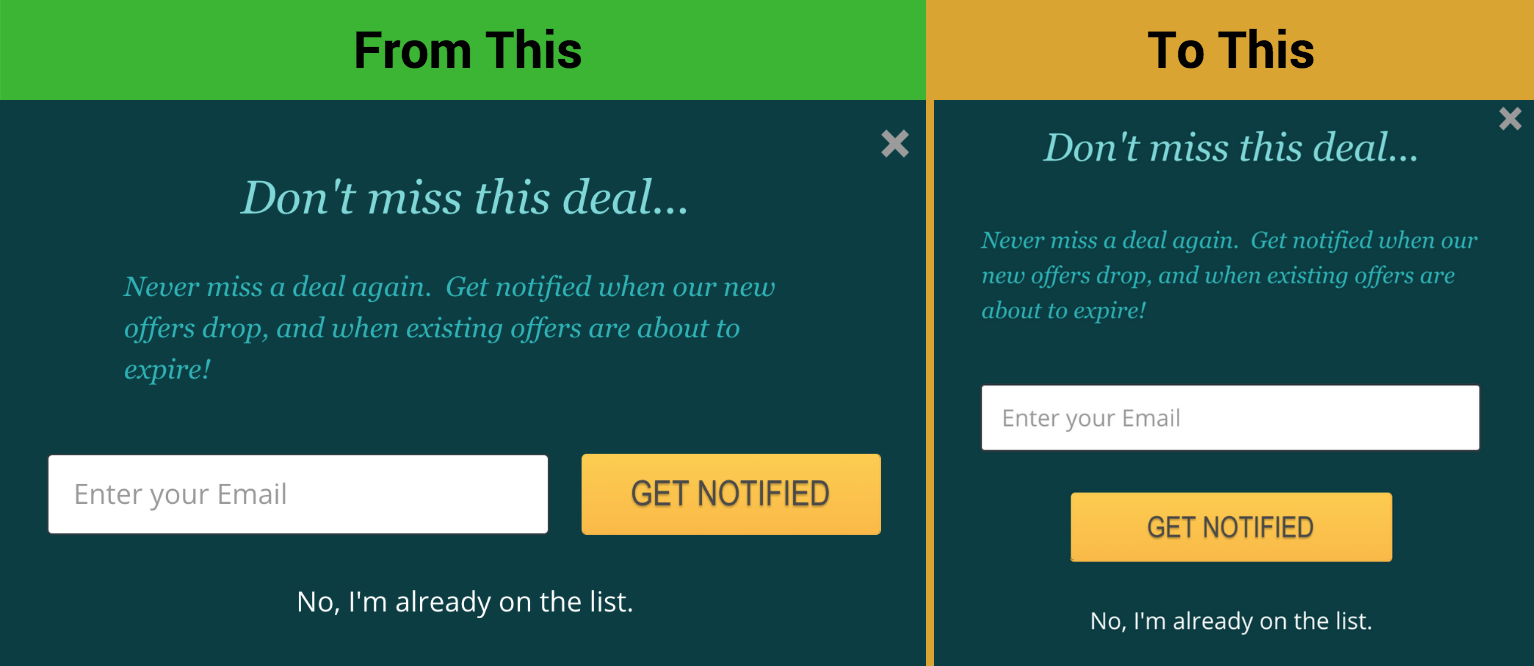
Timing and Display: As a visitor using a mobile device leaves the website (except pages like account or privacy policy, where you don't want to interrupt people)
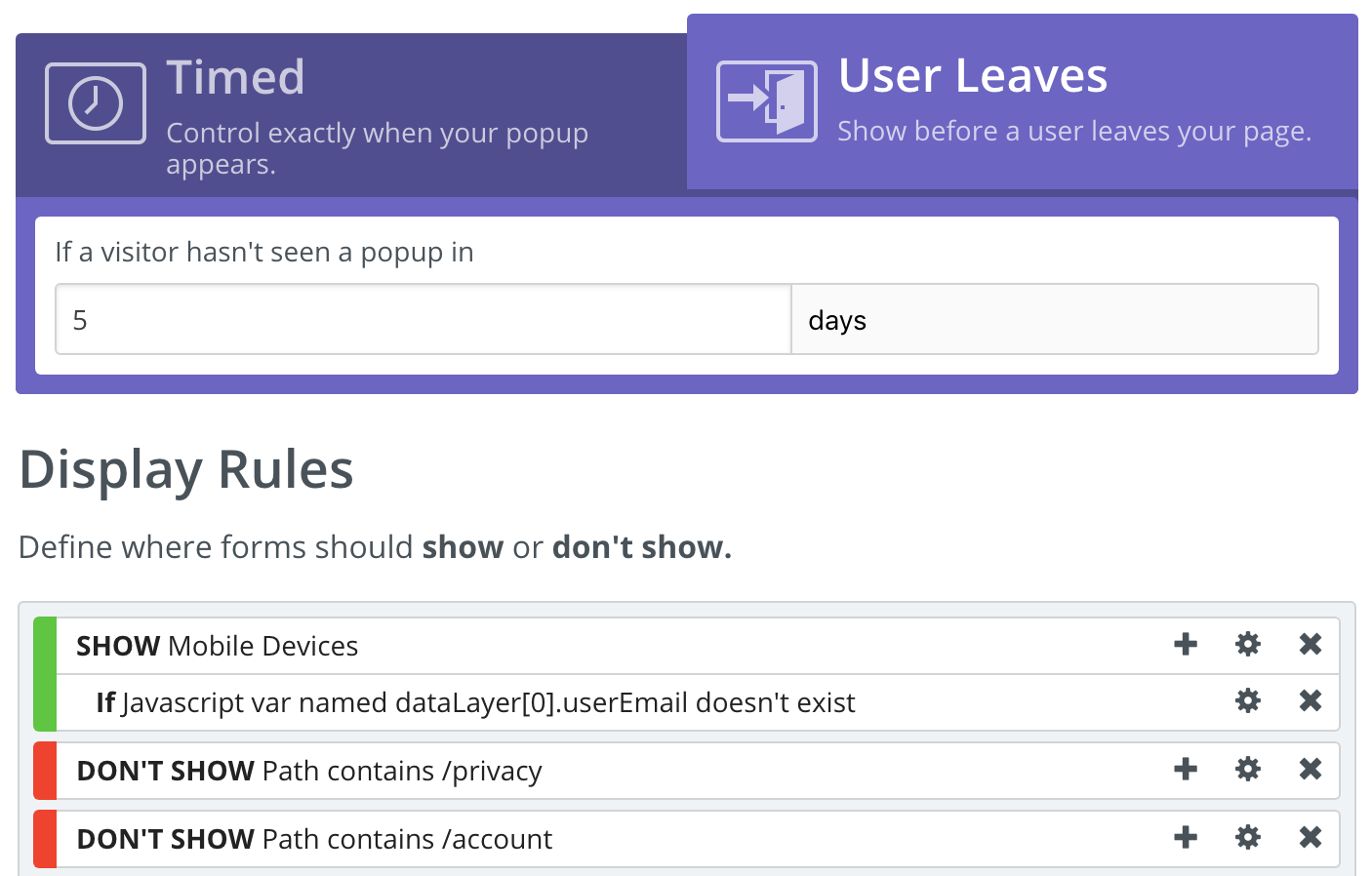
Result: Doubled AppSumo’s email opt-ins in one day with a 100.49% increase in mobile conversions and 2,022 new email subscribers


Why It Works:
- AppSumo took one of their highest-converting popups on desktop and changed the button position to improve the mobile layout.
- The new button layout roughly lined up right under the user’s thumb to make it easier to opt in while browsing on mobile (AppSumo has a lot of mobile traffic, so any improvement is a good win).
AppSumo List Building Popup #3
Popup Type: Expired Product Popup
Popup Design: Sumo “North” Template (available inside Sumo)
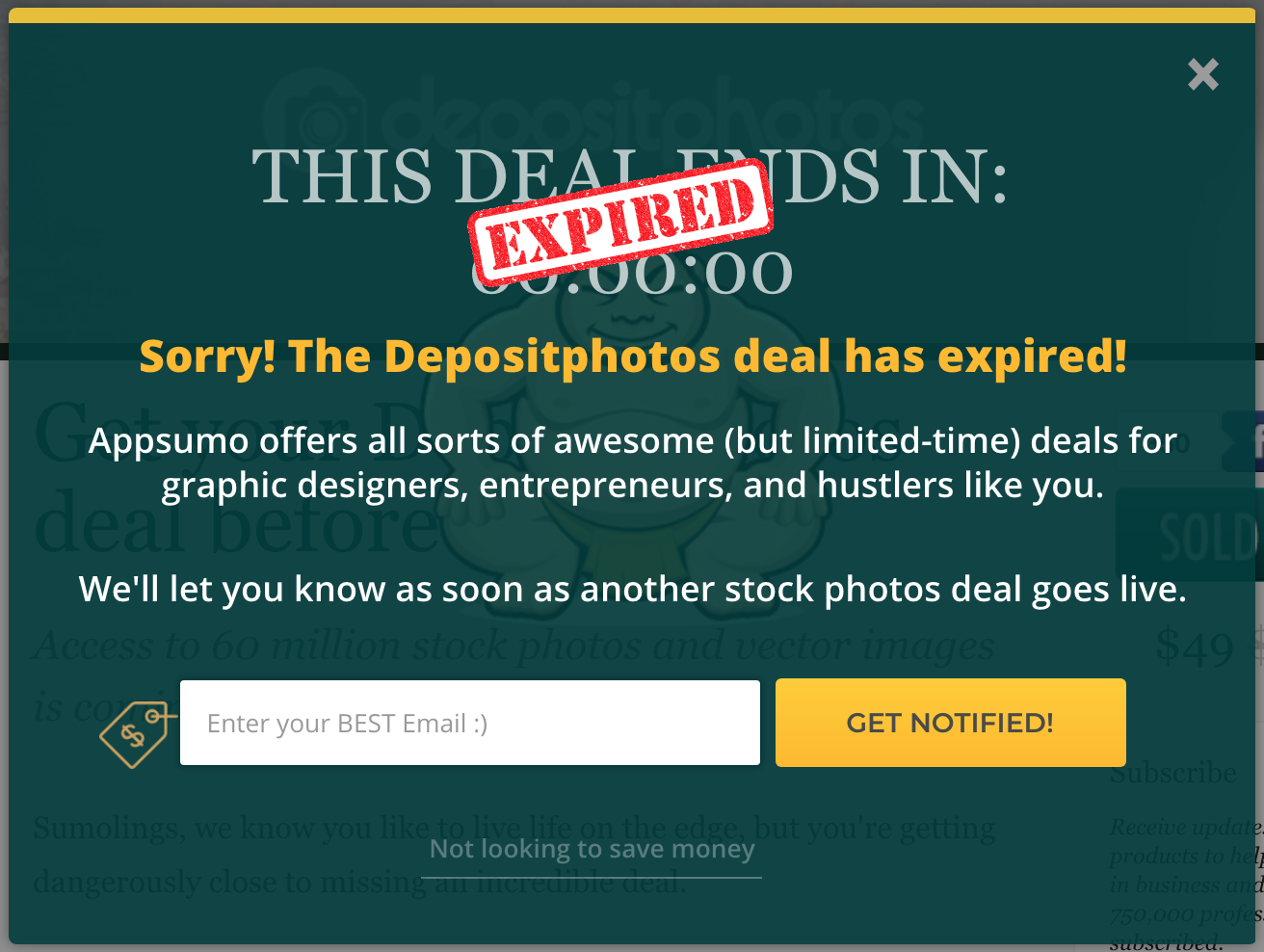
Timing and Display: All Depositphotos expired deal pages (plus AppSumo’s other top 10 expired deals)
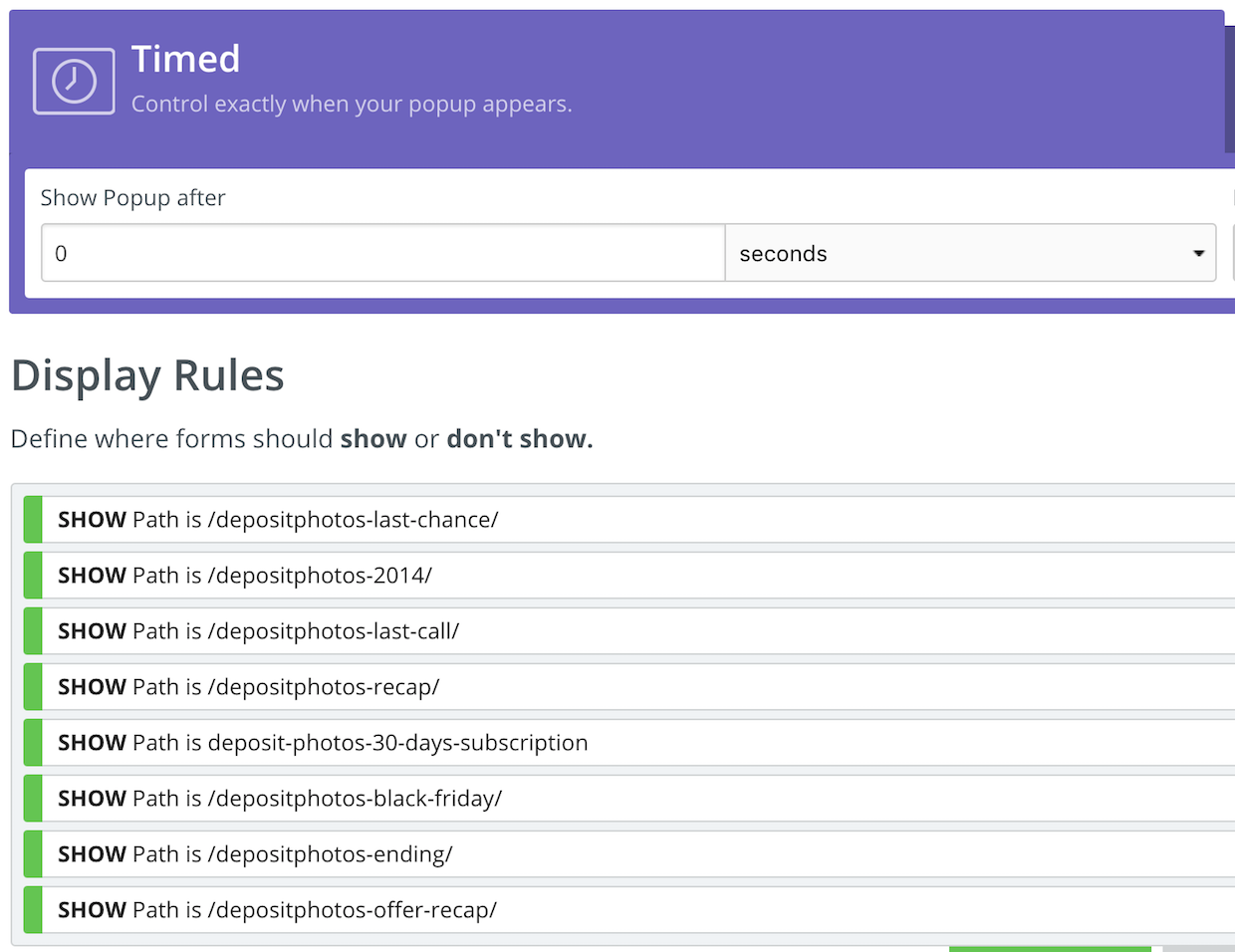
Result: 7.5% conversion rate and 58 email subscribers

Why It Works:
- It lets the visitor know that the deal isn’t live anymore, and collects their email, so they can get notified and not miss similar future deals.
- It improves user experience by letting people know the deal expired, yet still shows the valuable deals AppSumo has to offer. Many visitors come from catching up on months-old emails, and this beats showing them a sad taco.
- It uses separate popups for different individual expired deals. When people find an expired deal, the messaging is related to that individual software. This got the conversion rate up to 11.48% on one popup.
AppSumo List Building Popup #4
Popup Type: Referral Traffic Welcome Mat
Popup Design: Sumo “Creative” Template (available inside Sumo)

Timing and Display: Referral traffic from Tim Ferriss’s website

Result: 6.3% conversion rate and 704 email subscribers

Why It Works:
- It’s personalized based on the referral traffic source (Tim Ferriss website visitors see a Tim Ferriss-branded popup).
- It leverages the “association bias” (one of 25 cognitive biases people have) to make AppSumo seem more credible and trustworthy by associating their brand with someone they trust (Tim Ferriss).
- Tim’s readers are a little more “fun” so the buttons “GIMMIE!” and “Nah, I’m a nerd” tested better than just “Download” and “No Thanks.”
These are four of AppSumo’s most successful popup types. If you want help discovering which popup types can help grow your email list, you can get a free site optimization from Sumo’s Optimization Team when you visit this secret page (warning: only apply if you’re ready to grow your email list with an onslaught of new leads who are eager to buy what you sell).
The takeaway: There are four simple ways to grow your email list:
1) Come up with a relevant offer for your audience and promote it on a popup that is timed to show after people have been on your website for X seconds (AppSumo do this with an offer to get $100+ free stuff every month after someone has been on the site for 15 seconds)
2) Find your highest-converting email popup and create a mobile-optimized version with your call to action button below your email opt-in field (AppSumo do this for their sitewide deal notification popup that shows when someone tries to leave the website)
3) Put email popups on your expired product pages (AppSumo put it on their top 10 expired deal pages with the most traffic)
4) Create email popups on your website based on your referral traffic data (AppSumo create popups from big referral traffic sources like Tim Ferriss’ website)
AppSumo’s Full Multimillion Dollar Marketing Playbook
The person who uploads blog posts for Sumo left for New Zealand, so we didn’t get a chance to upload the rest of this AppSumo growth study for you.
If you like what you’ve read so far, you can click here to get access to AppSumo’s Full Multimillion Dollar Marketing Playbook.
Here’s what’s waiting for you inside:
- [Tip #4] Get Your Next Big Business Idea By Mixing 2 Markets Together (AppSumo = Web Apps + Daily Deals)
- [Tip #5] Send More Email, Make More Money (With The 12-Week Email Challenge)
- [Tip #6] AppSumo’s 12-Point Product Promotion Checklist (Exactly What Happens To Promote Every AppSumo Product)
- [Tip #7] 5 Things That Didn’t Work (Read This If You Want To Save 1 Year Hustlin’ Your Face Off)
- [Tip #8] How To Spend $11K And Make $329K With Facebook Ads In 1 Month (Hint: The “Thumb-Stop” Hack)
- [Tip #9] How AppSumo Launched A Million Dollar SaaS Company In 5 Months
- [Tip #10] Hire The Best Talent In The World (Hint: Hire People Who Impress The Shit Out Of You)
Get AppSumo’s Full Multimillion Dollar Marketing Playbook
Related Articles
%(relatedarticles)
Add A Comment
VIEW THE COMMENTS